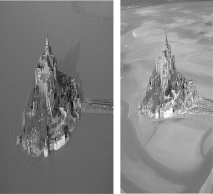Mt.Saint-Michel is separated from mainland Europe by approximately 1000 ft of relatively shallow water at high tide (as shown at left) ,but at low tide it is part of the wide,exposed intertidal zone (as shown at right) .What might you infer about the size the sediment clasts found on the exposed surface at low tide? 
A) The clasts are large because waves would remove small clasts.
B) The clasts are small because the wide, gently-sloped bottom would diminish wave strength, thus decreasing the waves' erosive power.
C) The clasts are large because the rough seas of the area routinely move large cobbles across the shallow bottom.
D) The clasts are salt particles that precipitate and grow when the tide is out and quickly dissolve when the tide comes in.
Correct Answer:
Verified
Q23: Gyres _.
A) rotate clockwise in the northern
Q24: Rogue waves arise from constructive interference of
Q25: Upwelling currents exist along the east coasts
Q25: The most prominent force inducing tides on
Q29: You are diving for treasure lost when
Q30: You are the captain of a submarine
Q31: Rip currents flow _.
A)directly toward the shoreline
B)directly
Q31: The worldwide average tidal range (difference in
Q32: Longshore currents flow _.
A)directly toward the shoreline
B)directly
Q34: As waves approach shore in shallow water
Unlock this Answer For Free Now!
View this answer and more for free by performing one of the following actions

Scan the QR code to install the App and get 2 free unlocks

Unlock quizzes for free by uploading documents